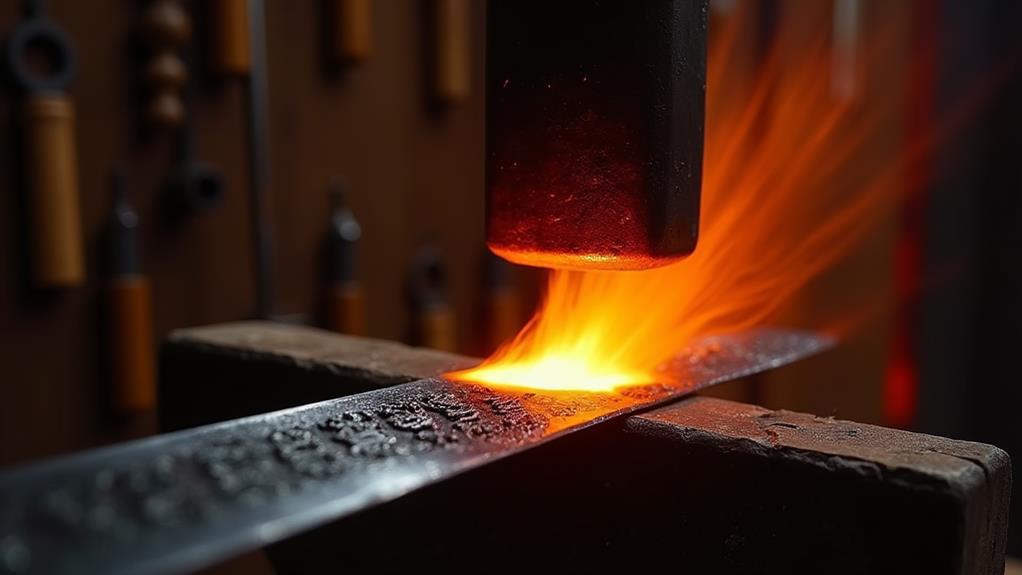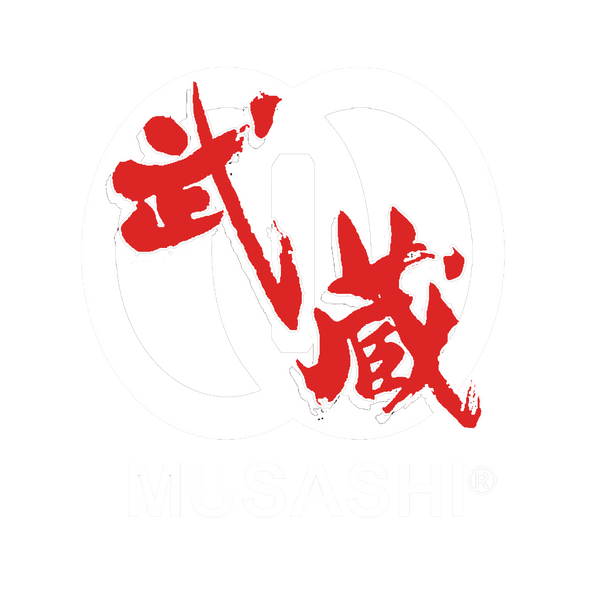
When you're looking for a really great katana, you'll hear about different kinds of steel. Tamahagane is the old-school choice that people love because it's super authentic. If you want a sword you can actually use, high-carbon steels like 1060 and 1095 are awesome because they're really hard and stay sharp for a long time.
L6 Bainite is super tough, and T10 tool steel is getting popular because it's hard and lasts a long time. Spring steels, like 5160 and 9260, are cool too because they can bend without breaking. Each type of steel is special in its own way, so it's fun to learn more about them to find the perfect katana for you. Keep reading to discover more cool stuff about these options!
Key Points
- High-Carbon Steels: Steel types like 1060 and 1095 are great for katanas you want to use. They're really hard and stay sharp for a long time.
- Tamahagane Steel: This is the traditional Japanese steel. It's special because of how it's made and what it means in Japanese culture.
- L6 Bainite: This steel is super tough and stays sharp. It's great if you want to use your katana a lot.
- T10 Tool Steel: More and more people are using this for modern katanas. It's really hard, tough, and stays sharp for a long time.
- Spring Steel: Types like 5160 and 9260 can bend without breaking. They're great for cutting tests and last a long time.
Cool Steel Types for Katanas
When you're picking steel for a katana, there are some really cool options. Each one is special in its own way:
Tamahagane is the old-school Japanese steel that everyone thinks is super cool. It has lots of carbon in it and looks really pretty up close. If you want a real traditional katana, this is the way to go.
High-carbon steels like 1095, 1080, and 1060 are awesome because they're hard, tough, and stay sharp for a long time. Lots of people like these for katanas they actually want to use.
L6 Bainite is super tough. If you want a sword that won't break easily but will still stay sharp, this is a great choice.
T10 tool steel is getting more popular. It's really hard and tough, which is why sword makers like it, even though it's not traditional.
Spring steel, like 5160 and 9260, is cool because it can bend without breaking. This is great for when you're doing cutting tests.
Each type of steel has something special about it, so think about what you want to do with your katana and pick the one that feels right for you.
How Katana Blades Are Made
Understanding how katana blades are made is super important when you're picking one. The way they're made changes how well they work and how cool they look. This helps you find a blade that you'll really love.
For example, Maru Steel is a simple and cheaper option, which is great if you're just starting out. These katanas are made from one type of steel and are really tough.
Composite Steels are cool because they mix a hard edge with a softer middle part. This gives you a sword that's sharp but can also take some hits - perfect if you want something strong but flexible.
If you like swords that look really pretty, check out Laminated Steels like Damascus. These mix different types of steel to make cool patterns, and they still have lots of carbon to stay sharp.
The way the sword is forged (like Kobuse and Honsanmai) is also super important. It changes things like how strong the sword is and what shape it has.
Learning about all these different ways of making blades helps you connect more with your katana. It becomes more than just a sword - it becomes a real friend on your journey.

What Makes Katanas Cost Different Amounts
Katanas can cost very different amounts, and things like what they're made of and how they're made change the price. If you want to buy a really good katana, it's important to know about these things.
Swords made of stainless steel usually cost less than 100, but if you want a real samurai sword made from Tamahagane steel, you might have to spend more than 1,000.
High carbon steels like 1060 and 1095 are in the middle - they're tough but don't cost too much. They usually cost between 200 and 1,000. How good the person who made the sword is also changes the price. If it's made in a special way or by someone really skilled, it will cost more.
Some katanas have cool features like being harder in some parts or made from layers of steel. These are often more expensive, especially for people who collect swords.
Also, think about how good all the parts of the sword are, how well it's balanced, and how it looks. These things make a big difference in how much it costs. A really well-made katana doesn't just look awesome - it feels great when you hold it, which makes you feel more connected to the cool history of these swords.
What Makes a Katana Really Good
When you're buying a katana, it's cool to know about all the work that goes into making a really good one. The stuff it's made from and how it's made are super important for making sure it works well and looks awesome.
When you're looking for a katana, here are some cool things to look for:
-
High-Carbon Steels: Blades made from 1095 or 1060 steel are really hard and stay sharp for a long time.
-
Old-School Ways of Making Them: Things like making the blade harder in some parts and using special Tamahagane steel make the sword work better and feel more real.
-
Cool Patterns on the Blade: A really well-made katana has a special line on it (called a hamon) and a cool pattern in the steel. This shows it was made in a special way.
-
Lots of Attention to Details: Everything about the sword, from the small parts to how it feels when you hold it, makes it good.
-
How Well It's Made: The skill of the person who made the sword is super important. It changes how the sword feels and looks, making each katana really special.
When you know about these things, you can really see how cool and useful a good katana is.
It's not just a weapon - it's like a piece of history. It shows how strong and artistic it is, which is awesome for anyone who likes things that are made really well.

Cool Stuff from Katana Stores
When you go to stores that sell katanas, you'll see they talk a lot about certain types of steel. This is cool for people who collect swords and people who use them for martial arts. The different types of steel show how special Japanese swords are, and it makes sword fans feel like they're part of something cool. Check out some popular steel options:
| Steel Type | What's Cool About It | Great For |
|---|---|---|
| High-Carbon Steels | Hard and tough | Swords you want to use |
| Tamahagane Steel | Old-school, fancy option | Real samurai swords |
| Spring Steels | Can bend a lot | Cutting tests & using a lot |
| Tool Steels (T10) | Stays sharp for a long time | People who like modern swords |
| Folding Process | Makes the sword stronger and prettier | Artistic katana blades |
Many katana stores really like high-carbon steels like 1060 and 1095 because they work really well. Tamahagane steel is special because it's part of Japanese culture, while spring steels like 5160 and 9260 are great because they can bend without breaking. Tool steels, like T10 steel, are getting more popular because they stay sharp and last a long time. Stores often tell you about how the swords are heated up and folded, which helps you understand how these awesome Katana blades are made.
Frequently Asked Questions
What's the Best Steel for a Katana?
When you're picking steel for your katana, think about how much carbon is in it, how bendy the blade is, and how long it stays sharp. The old way of making swords and how they're heated up makes them work better. Taking care of your sword helps it last longer. Different mixes of metal make the blades special and really good.
What's the Best Steel for Swords?
When you're looking for the best steel for swords, think about how much carbon is in it, how it's heated up, and how it's folded. Try to find a balance between how tough the blade is, how long it stays sharp, and how bendy it is. It's cool to mix old ways of making swords with new ideas.
What Kind of Steel Were Old Katanas Made Of?
Old katanas were made with steel that has a lot of history. They used old ways of making swords but also some new ways. The steel had lots of carbon in it to make the blade hard and keep it sharp. The way they folded the steel was really important because it showed how skilled the sword makers were and was part of their culture.
Is T10 Steel Better Than 1095?
When you're comparing T10 steel and 1095 steel, think about how long they stay sharp and how tough they are. T10 is really good at staying strong for a long time, while 1095 has more history behind it. Some people like one more than the other. The price might also help you choose which one you want.
Conclusion
So, now you know all about the different types of steel used to make awesome katanas. Picking the right steel is super important for making a really good sword. You've learned about how they make the blades and what makes some katanas cost more than others. Knowing what makes a katana really good helps you choose the best one. When you buy swords from a reputed store like our Store Musashi Swords, remember all this cool stuff to find a blade that's perfect for you. With all this knowledge, you can really see how amazing these swords are and how much skill goes into making them. Our Store Musashi Swords has lots of katanas that show off all these cool things we talked about.


